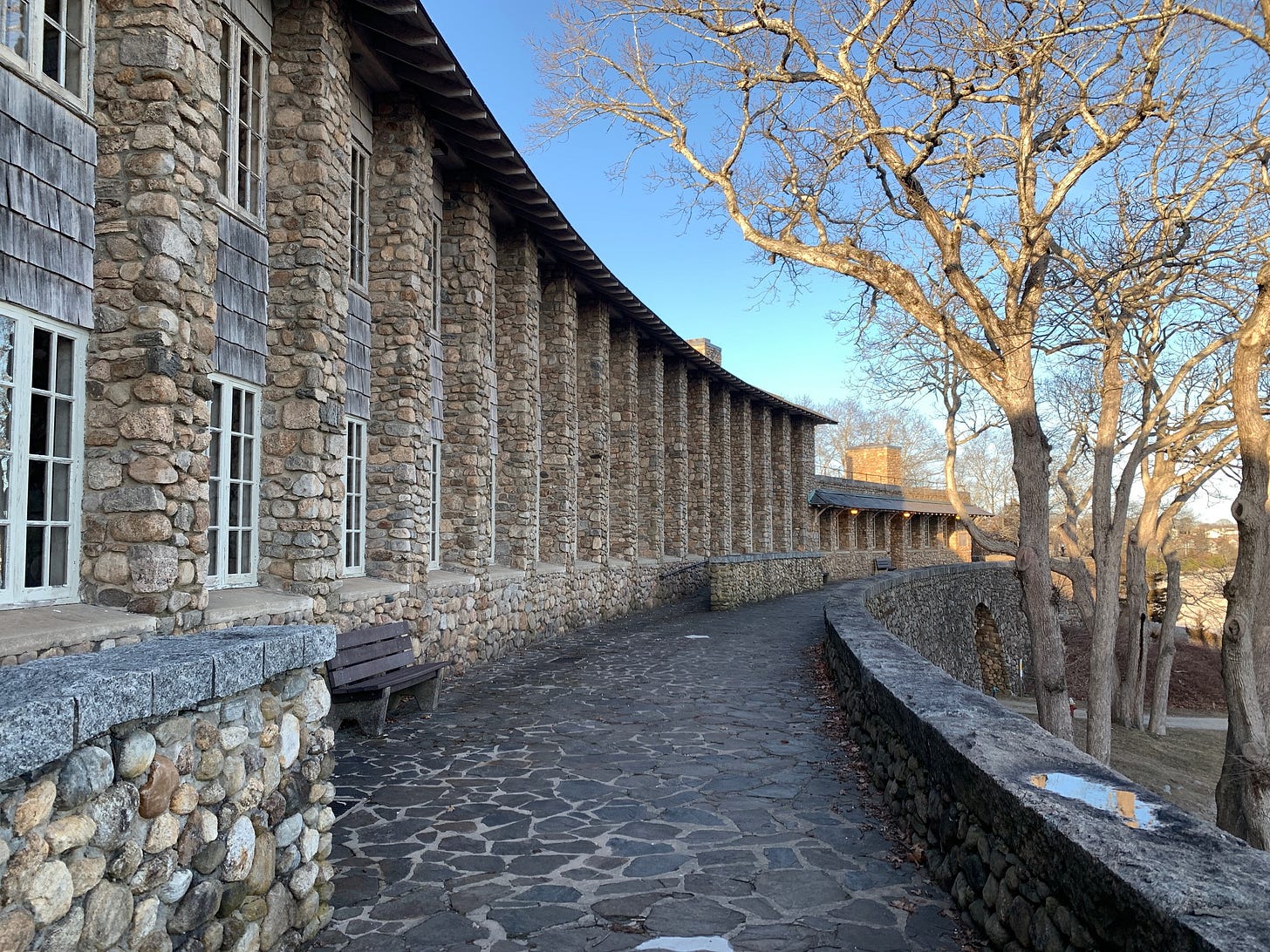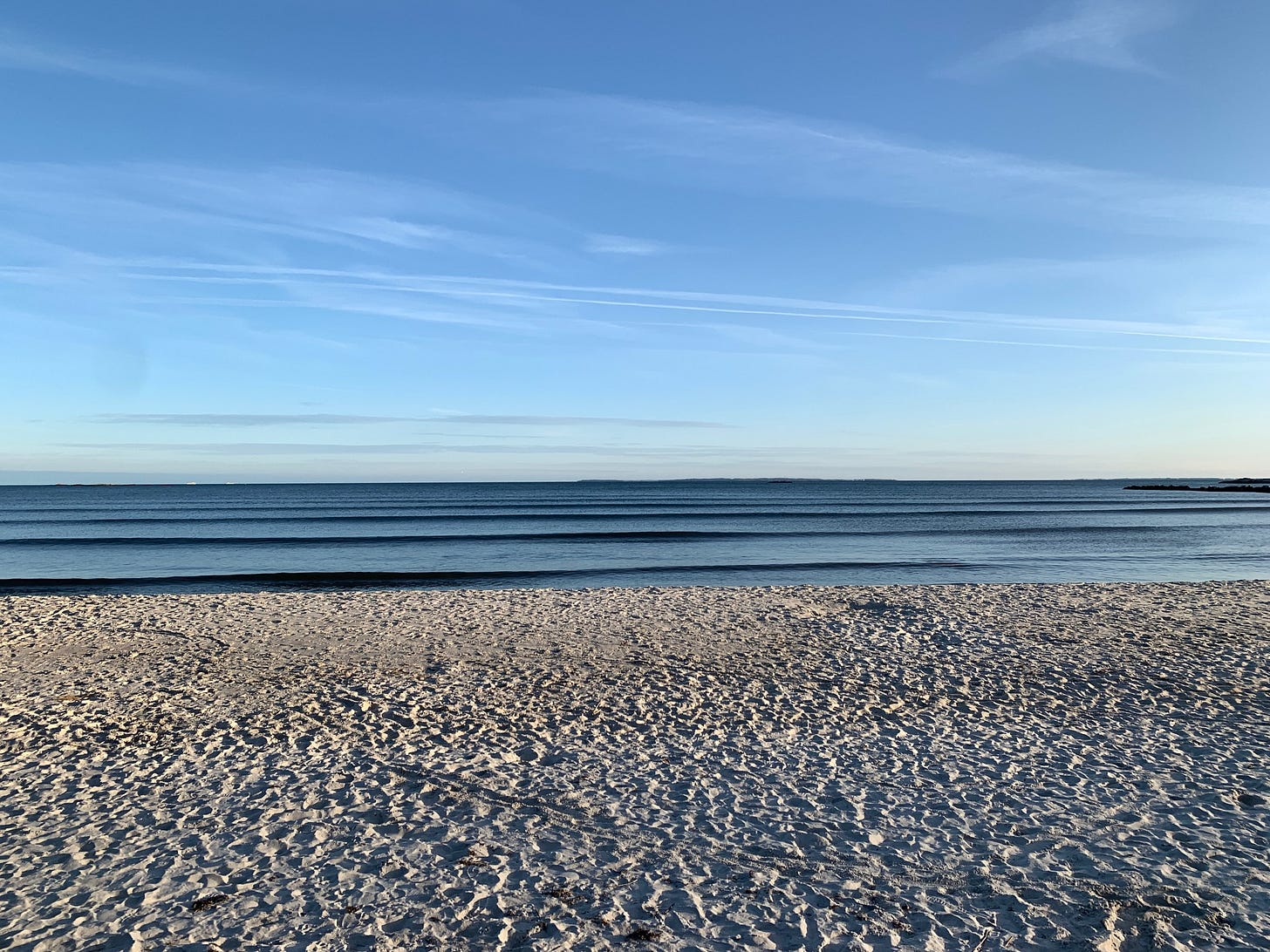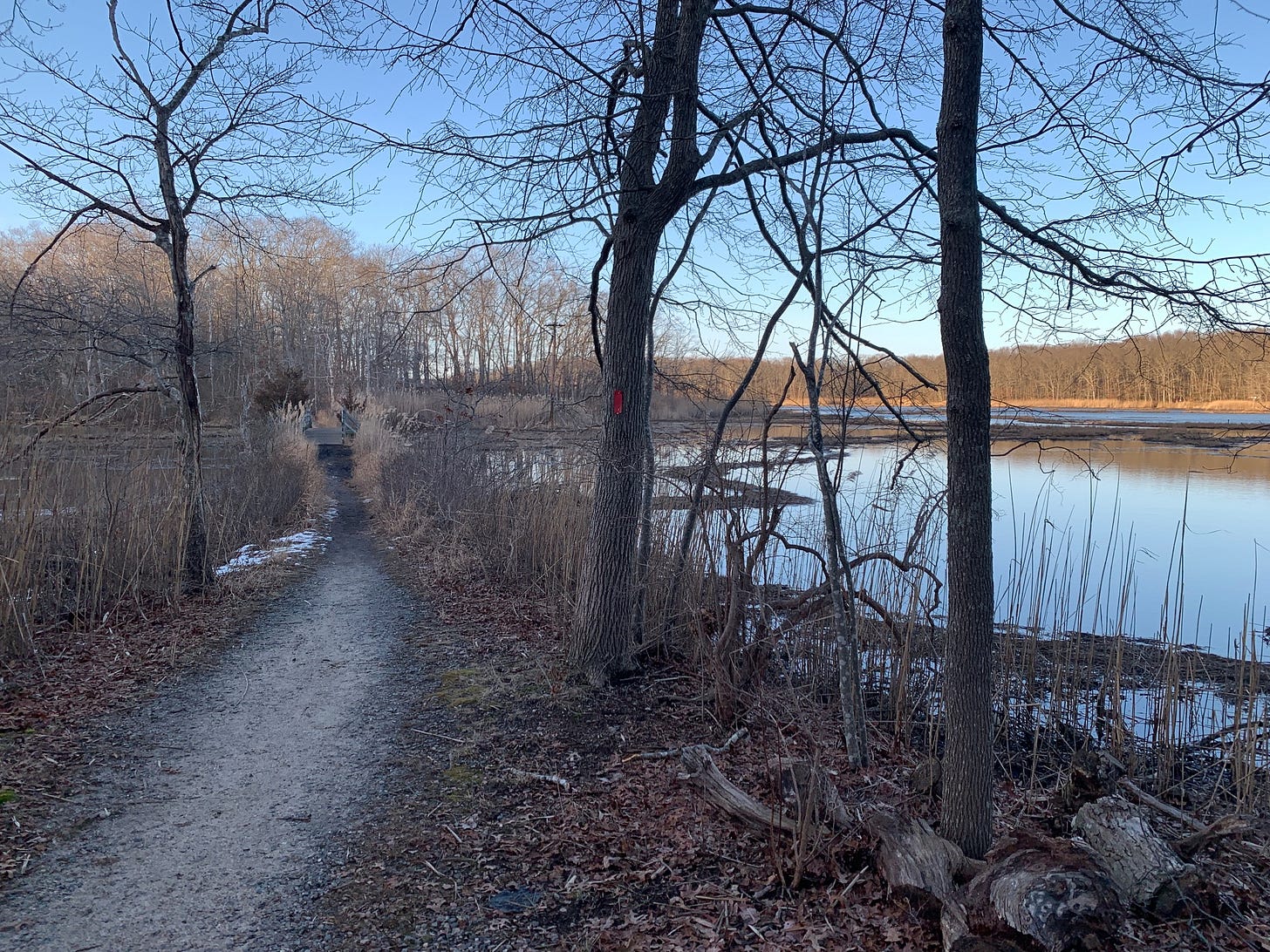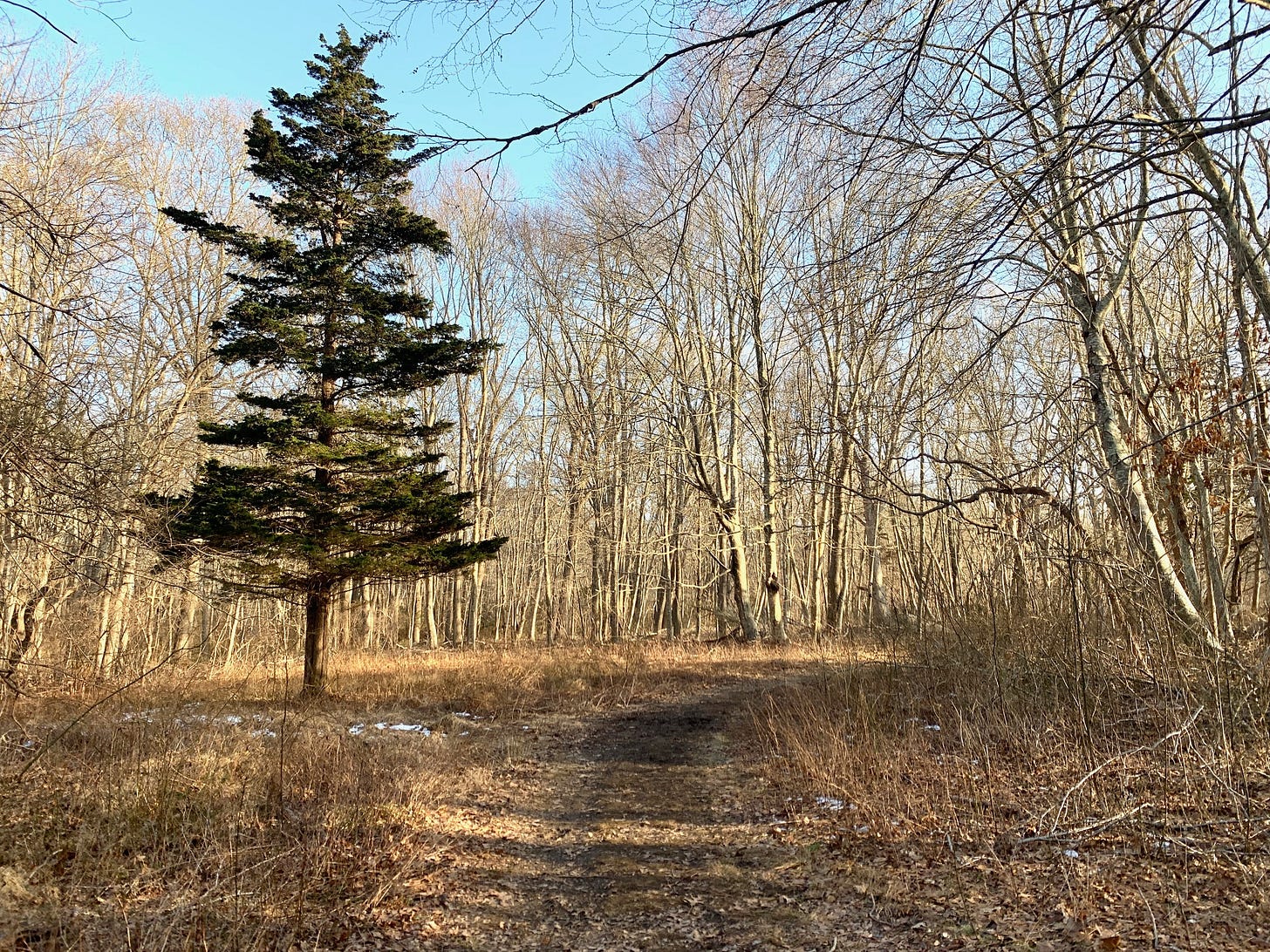One of my more specific memories of growing up in the Nineties is watching a lot of music videos in which the lead singer is skulking around on an empty beach. I’m not sure how or why this became a video motif, but an empty beach—especially in winter—is such an effortlessly atmospheric and moody place that I can understand why the directors decided to shoot all of these bands on the sand. To this day, whenever I end up listening to Coldplay (which happens maybe twice per year) it’s impossible for me not to think of Chris Martin in a raincoat walking past the surf, crooning “And it was aaawwwlll yellow.”
New England is full of beaches that are lonely and mercurial during the majority of the year, when the summer crowds are sequestered inland. And I’ve found it surprising that we just abandon the coast like this, as soon as it becomes just a little more cumbersome to be outside. Being in an austere environment has a special, more esoteric beauty of its own, and it imbues any subsequent cozy activities with an extra slab of deliciousness. But as I was driving home from a work trip to New York the other weekend, along the Connecticut stretch of I-95, it occurred to me that we only have a few more months left before the crowds descend upon New England’s beaches. In other words, your window for having a brooding, bundled-up day at the beach has begun to close!
So I decided to take advantage of the time and place, by paying a pre-sundown visit to one of the Nutmeg State’s most bounteous beaches—a destination where people compete for parking spots and campsites from June through September, but where you can just waltz in (for free!) during the chillier months; with full access to the woods and waters that abut the sandy beach.
I’m not entirely sure how Rocky Neck State Park got its name (and I’ve done some digging) but I’d imagine it comes down to two things. This 710-acre peninsula extends from the East Lyme shoreline like a neck, and it’s chock full of rocks. The woods of Rocky Neck State Park contain big old glacial boulders speckled with lichen, and on the higher ridge of the peninsula, bedrock is exposed—giving this slice of the shore a distinctive mountain flavor. But the star attraction of the park is its sandy beach that overlooks Long Island Sound. Reliably alive with oiled-up visitors in the summer, the beach is abutted by several enormous parking lots and also, a gorgeous stone pavilion which contains wooden pillars harvested from other Connecticut state parks. On the west side of the park, you’ve got the Four Mile River (which appears to be a lot longer than four miles) and on the east, there’s Bride Brook—a marshier, reedier thing. Two rivers. One beach. And a fuck ton of rocks. What could be more Southern New England?
The easiest way to reach the beaches and trails at Rocky Neck State Park is to park in one of the lots. From April through October, this will cost you $15 on weekdays and $22 on weekends (Connecticut residents get a discounted rate). Admission fees are not collected during the frostier off-season. But if you happen to be visiting during the November-March window—which, again, is now closing!—there’s a more engrossing option for getting into the state park. On the shoulder of Route 156, you’ll find a small parking area with a porta-potty, directly across the road from a KOA campground that’s seasonally shuttered right now. And if you can bag a parking spot at this lot, which is much easier in the winter than during the temperate months, you can follow one waterway through the stony forest to the beach, enjoy some solo time ambling on the sand, and follow the other waterway back to your car once you’re finished.
Another reason why you might want to make this micro-pilgrimage right now is because we’re almost through the worst of New England winter! I know it’s considered heresy to say that in early March, but I don’t care. We need things to look forward to and get excited about. And as you walk south through the woods and the meadowy coastal thickets of Rocky Neck State Park, heading for the Four Mile River, the sudden heft of blue water that you’ll soon see ahead of you through the trees might get your brain crackling away with anticipation for the not-so-distant months when we can actually do things in the water outside. I started my hike to the beach just after 4pm and by the time I first saw the river, there was still plenty of light in the sky. Enough to make it to the beach and back to the car without worrying about my headlamp batteries. A harbinger of good times to come.
When you first see Four Mile River, it can be kind of surprising to realize that you’re a couple hundred feet above the river, gazing down at it. But the trail makes good use of its exposed rock slabs and offers a surprisingly easy descent toward the water’s edge. A train trestle for Amtrak and the MTA’s Metro-North Railroad crosses over the river near the beach, and that bridge is what you’ll be aiming for. And once the trail veers inland, away from the river and into a parking lot, a smaller, arched pedestrian bridge allows you to pass above the railroad tracks. On the other side, you’ll find yourself standing on the terrace of the Ellie Mitchell Pavilion, staring down at the sandy state park beach to your left and Rocky Neck’s evergreen speckled tip to your right. In the summer, it feels like the kind of space where the landed gentry would have congregated with cigarillos and mini-binoculars on sticks, watching the hordes competing for real estate on the beach. But in the winter, you’ll probably have the terrace to yourself; like Julianne Moore or Jeff Goldlbum wandering around the abandoned theme park in The Lost World: Jurassic Park.
Granted, you’re not *that* alone at the beach of Rocky Neck. You can see plenty of East Lyme homes to the west, on the water’s edge. But that’s one of the coolest things about an area as dense and environmentally diverse as New England. You can be in the middle of nowhere in the middle of a community, and the off-season coasts of New England might be the most opportune places for experiencing this odd feeling. When I stepped onto the beach, I put in my earbuds, cued up Spotify, and spent the next eight minutes playing the main character in my own imaginary music video for Massive Attack’s “Safe From Harm.” The closing guitar loop kicked in at 6:27, just as I passed a handsomely-dressed older couple walking their yellow lab, and I wondered if they often witness scenes like this: lone visitors, trawling the local sands, banging their heads against the cold seabreeze to a private melody.
When the song ended, the sun had receded and I knew it was time to follow Bride Brook back home. One cool thing about Bride Brook that I had read about years prior is that it contains one of the largest herring runs in the Nutmeg State! The fish enter the brook via two culverts at the beach and use these built passages as on-ramps for Bride Brook, which connects to freshwater lakes and ponds where the fish can gather and get it. (When reading about this, I also learned that herring are sometimes referred to as “alewives,” apparently because they reminded 19th Century New Englanders of what a bartender might start to look like after too many brown ales.) As I crossed a wooden bridge over a marshier section of Bride Brook, re-entering the woods on the other side, I remembered that the next Connecticut herring run will be happening around May, when the beaches are still relatively quiet. For all I knew, there could have already been a few fish invisibly commuting upstream through the culverts as I walked alongside Bride Brook.
And that’s the funny thing about lonely beaches. Even when the crowds have gone home to hibernate, even when there are no coastal homes in sight…you’re never really alone here. There are seasonal gatherings of living things happening on and around the beach throughout the year, beyond our field of perception. Beneath the winter waves of the Chesapeake Bay, scores of Lion’s Mane Jellyfish are still frolicing. Under the sands of Odiorne Point State Park in coastal New Hampshire, clam worms are waiting for the night to fall, so they can emerge and gorge themselves on unlucky crustaceans. The idea of the lifeless beach is an illusion, and I can’t help but wonder what a more honest representation of seemingly empty beaches might look like in pop culture. I’m picturing a school of herring—tens of thousands of them—furiously swimming upstream to the trance beat of Armin Van Buuren’s “Sail,” en route to the greatest party on earth, in the murky recesses of some lake.
We should all be so lucky.
Rocky Neck State Park beach loop
Hike distance: 2.9 miles
Elevation gain: 174 feet
CLICK HERE for an AllTrails map
CLICK HERE for a state park trails map
And here's this week's audio episode of Mind The Moss.








Beautiful article. Almost makes me sad that winter is on its way out